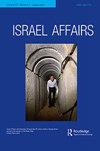阿亚图拉·霍梅尼解决巴以冲突及其长期后果的方法
IF 0.6
4区 社会学
Q3 AREA STUDIES
引用次数: 0
摘要
摘要本文考察了阿亚图拉·鲁霍拉·霍梅尼为建立反对巴列维统治的革命性反对派所做的长期努力,同时利用伊朗和以色列之间不断发展的关系作为他发表宣言的蓝图。霍梅尼的反以色列政策既有反犹太主义的成分,也有反犹太复国主义的成分,这使得伊朗反对国王和以色列的不同派别聚集在一起。这种相互仇恨的交集巩固了霍梅尼的支持者和黎巴嫩巴解组织之间的关系,尽管他们在神学上存在重大分歧。伊斯兰革命带来的变化导致了身份、价值、规范和政策的重新调整,这对以色列产生了重大影响,今天仍然需要一种新的分析框架。目前,伊斯兰政权继续利用巴勒斯坦的叙述作为杠杆,企图实现地区霸权,并保持其在穆斯林世界的领导地位。关键词:霍梅尼,以色列,伊朗,普洛梅洛姆,礼萨,巴列维,伊斯兰革命,伊斯兰共和国,真主党,巴勒斯坦反犹太主义披露声明作者未报告潜在的利益冲突。https://www.bbc.com/persian/articles/cg3rnqn8q28o.2。比阿勒,《伊朗关系》。杰维斯,<安全困境下的合作>。有关伊朗作家出版物的概述,请参见:Velayati, Iran va Tahavolat- e Palestine;Murteza, Diplomasi-ye Penhan;Rad, hamkarie Savak va Mussad;哈吉·尤塞夫,伊朗现政权的忠实支持者;3 .礼萨,ertebate nashenokhte。伊察科夫,《伊朗的圣城日》Taroujani,“Tarikh-e Ma 'aser-e Iran az Didgah-e Imam-e Khomeini”,317-18.6。阿亚图拉·霍梅尼的治理概念>,第7页。《伊朗的宗教与政治》,第8页。伊察科夫,伊朗-以色列1948-1963.9。《阿亚图拉·霍梅尼的治理概念》,807-8.10。拉希米,<革命前伊朗什叶派意识形态的兴起>,第11页。Kohlberg, <从Imamiyya到Ithnä- ' ashariyya >沙维特和温特,《我的敌人,我的导师》霍梅尼,Velayat-e Faqih Hokumat-e Eslami, 70-71.14。现代中东的自由与正义>,第15页。伊兹查科夫,<伊朗坚定不移的以色列仇恨>,第16页。凯迪和理查德,《革命的根源》,140.17。《伊朗政治》,158-9.18。祖拜达,伊斯兰教,人民与国家,253-9.19。Abrahamian, <伊朗的游击运动>,第20页。伊朗政治,156.21。Murteza, Selselhay-e Pahlavi, 104.22伊斯兰共和党成立于1979年,并于1987年解散。伊察科夫,伊朗-以色列1948-1963,45-6.24。塔格哈维,<法达伊扬-伊斯兰>,第25页。拉希米,“民主权威”,198.26。摩加达姆,<混乱、神话和殉难> 136.27。《革命后的伊朗和什叶派黎巴嫩》,第28期。夏皮拉,真主党,75-6.29。Nasr,《什叶派复兴》,71-2.30页。关于沙里亚蒂的“伊斯兰社会学”的分析,见:祖拜达,伊斯兰,人民与国家,71-8页。关于沙里亚蒂的个人生活,见:阿贝迪,“阿里沙里亚蒂。”arjmand, <改革运动> 32。Moghadam, <混乱、神话和殉难> 139.33。《阿里·沙里亚提论巴勒斯坦问题》34。夏皮拉,真主党,97.35。Abrahamian,“伊朗的游击运动”,第8-9.36页。沙阿的黎巴嫩政策> 37。夏皮拉,真主党,81.38分。Samii,“沙阿的黎巴嫩政策”,80.39。沙皮拉,“谁是杀害伊玛目穆萨萨德尔的幕后黑手?”《革命后的伊朗和什叶派黎巴嫩》,第280.41页。阿贾米,消失的伊玛目,93.42。穆萨·萨德尔于1978年8月在前往利比亚的途中失踪。夏皮拉,真主党,81-2.44。齐瑟,黎巴嫩,60.45。建国十年后,阿迈勒的地位开始输给真主党,后者逐渐发展成为黎巴嫩政治中最具统治力的政党。夏皮拉,《谁是幕后主使》166.47。黎巴嫩的Zisser, 76.48。《革命后的伊朗和什叶派黎巴嫩》,第273-4.49页。波玳:“从法赫德到阿布达拉。”见上面说明4。Nasr,什叶派复兴,73-9.52。伊朗与伊斯兰革命的传播> 53。伊兹查科夫,<伊朗必须妖魔化敌人以证明自己的正当性> 54。沃尔特,《革命与战争》55页。Kaye,以色列和伊朗。《软实力》,第57页。Menashri,《伊朗的地区政策》,第58页。Zisser,黎巴嫩,217-18.59。《叙利亚战争》60。Takeyh,“所有阿亚图拉的人”,54.61。巴以冲突的伊斯兰化> 62。夏皮拉,真主党,93.63。https://www.ynet.co.il/news/article/hyfbdkmz3#autoplay.Additional信息撰稿人说明doron Itzhakov doron Itzhakov是以色列巴伊兰大学贝京-萨达特战略研究中心的高级研究员。本文章由计算机程序翻译,如有差异,请以英文原文为准。
Ayatollah Khomeini’s approach to the Palestinian-Israeli conflict and its longstanding ramifications
ABSTRACTThis article examines the long term efforts made by Ayatollah Ruhollah Khomeini to create revolutionary opposition to the rule of Shah Mohammed Reza Pahlavi, while exploiting the evolving relations between Iran and Israel as a blueprint for his proclamations. Khomeini’s anti-Israel policies had both anti-Semitic and anti-Zionist components that contributed to mustering different segments of Iran’s opposition to the Shah and Israel. This intersection of the mutual animosities consolidated relations between Khomeini’s supporters and the PLO in Lebanon, despite their major theological differences. The change brought about by the Islamic Revolution led to a restructuring of identities, values, norms and policies, which affected Israel considerably and today still calls for a new framework of analysis. Currently, the Islamic regime continues to utilise the Palestinian narrative as leverage its attempts to achieve regional hegemony and maintain its leadership in the Muslim world.KEYWORDS: Ayatollah KhomeiniIsraelIranPLOMohammed Reza PahlaviIslamic revolutionIslamic RepublicHezbollahPLOanti-Semitism Disclosure statementNo potential conflict of interest was reported by the author(s).Notes1. https://www.bbc.com/persian/articles/cg3rnqn8q28o.2. Bialer, “The Iranian Connection.”3. Jervis, “Cooperation Under the Security Dilemma.” For an overview of Iranian writers publications, see: Velayati, Iran va Tahavolat- e Palestine; Murteza, Diplomasi-ye Penhan; Rad, Hamkari-e Savak va Mussad; Haji Yousefy, Iran va Regime-ye Sahyonisti; and Reza, Ertebat-e Nashenokhte.4. Itzchakov, “Iran’s Quds Day.”5. Taroujani, “Tarikh-e Ma’aser-e Iran az Didgah-e Imam-e Khomeini,” 317–18.6. Mavani, “Ayatullah Khomeini’s Concept of Governance.”7. Chehabi, “Religion and Politics in Iran.”8. Itzchakov, Iran-Israel 1948–1963.9. Mavani, “Ayatullah Khomeini’s Concept of Governance,” 807–8.10. Rahimi, “The Rise of Shi’i Ideology in Pre-Revolutionary Iran.”11. Kohlberg, “From Imamiyya to Ithnä-’ashariyya.”12. Shavit and Winter, “My Enemy, My Mentor.”13. Khomeini, Velayat-e Faqih Hokumat-e Eslami, 70–71.14. Lewis, “Freedom and Justice in the Modern Middle East.”15. Itzchakov, “Iran’s Unwavering Israel-Hatred.”16. Keddie and Richard, Roots of Revolution, 140.17. Chehabi, Iranian Politics, 158–9.18. Zubaida, Islam, The People and the State, 253–9.19. Abrahamian, “The Guerrilla Movement in Iran.”20. Chehabi, Iranian Politics, 156.21. Murteza, Selselhay-e Pahlavi, 104.22. The Islamic Republican Party was founded in 1979 and disbanded in 1987.23. Itzchakov, Iran-Israel 1948–1963, 45–6.24. Taghavi, “Fadaeeyan-i Islam.”25. Rahimi, “Democratic Authority,” 198.26. Moghadam, “Mayhem, Myths, and Martyrdom,” 136.27. Shaery-Eisenlohr and Shaery-Eisenlohr, “Post-Revolutionary Iran and Shi’i Lebanon.”28. Shapira, Hezbollah, 75–6.29. Nasr, The Shi’a Revival, 71–2.30. For an analysis of Shariati’s “Islamic Sociology,” see: Zubaida, Islam, The People and the State, 71–8. About Shariati’s personal life see: Abedi, “Ali Shariati.”31. Arjomand, “The Reform Movement.”32. Moghadam, “Mayhem, Myths, and Martyrdom,” 139.33. Ahouie, “Ali Shariati on the Question of Palestine.”34. Shapira, Hezbollah, 97.35. Abrahamian, “The Guerrilla Movement in Iran,” 8–9.36. Samii, “The Shah’s Lebanon Policy.”37. Shapira, Hezbollah, 81.38. Samii, “The Shah’s Lebanon Policy,” 80.39. Shapira, “Who Was Behind the Killing of Imam Musa Sadr?”40. Shaery-Eisenlohr and Shaery-Eisenlohr, “Post-Revolutionary Iran and Shi’i Lebanon,” 280.41. Ajami, The Vanished Imam, 93.42. Musa al-Sadr disappeared on August 1978 in a journey to Libya.43. Shapira, Hezbollah, 81–2.44. Zisser, Lebanon, 60.45. A decade after its establishment, Amal began losing its status to Hezbollah, which evolved as the most dominant party in Lebanon’s politics.46. Shapira, “Who Was Behind the Killing,” 166.47. Zisser, Lebanon, 76.48. Shaery-Eisenlohr and Shaery-Eisenlohr, “Post-Revolutionary Iran and Shi’i Lebanon,” 273–4.49. Podeh, “From Fahd to Abdallah.”50. See note 4 above.51. Nasr, The Shia Revival, 73–9.52. Hunter, “Iran and the Spread of Revolutionary Islam.”53. Itzchakov, “Iran Must Demonize Its Enemies to Justify Itself.”54. Walt, “Revolution and War.”55. Kaye, Israel and Iran.56. Nye, Soft Power.57. Menashri, “Iran’s Regional Policy.”58. Zisser, Lebanon, 217–18.59. Dekel, The War in Syria.60. Takeyh, “All the Ayatollah’s Men,” 54.61. Litvak, “The Islamization of the Palestinian-Israeli Conflict.”62. Shapira, Hezbollah, 93.63. https://www.ynet.co.il/news/article/hyfbdkmz3#autoplay.Additional informationNotes on contributorsDoron ItzhakovDoron Itzhakov is a Senior Research Associate at the Begin-Sadat Center for Strategic Studies, Bar-Ilan University, Israel.
求助全文
通过发布文献求助,成功后即可免费获取论文全文。
去求助
来源期刊

Israel Affairs
AREA STUDIES-
CiteScore
0.70
自引率
25.00%
发文量
65
期刊介绍:
Whether your major interest is Israeli history or politics, literature or art, strategic affairs or economics, the Arab-Israeli conflict or Israel-diaspora relations, you will find articles and reviews that are incisive and contain even-handed analysis of the country and its problems in every issue of Israel Affairs, an international multidisciplinary journal. Scholarly and authoritative, yet straightforward and accessible, Israel Affairs aims to serve as a means of communication between the various communities interested in Israel: academics, policy-makers, practitioners, journalists and the informed public.
 求助内容:
求助内容: 应助结果提醒方式:
应助结果提醒方式:


